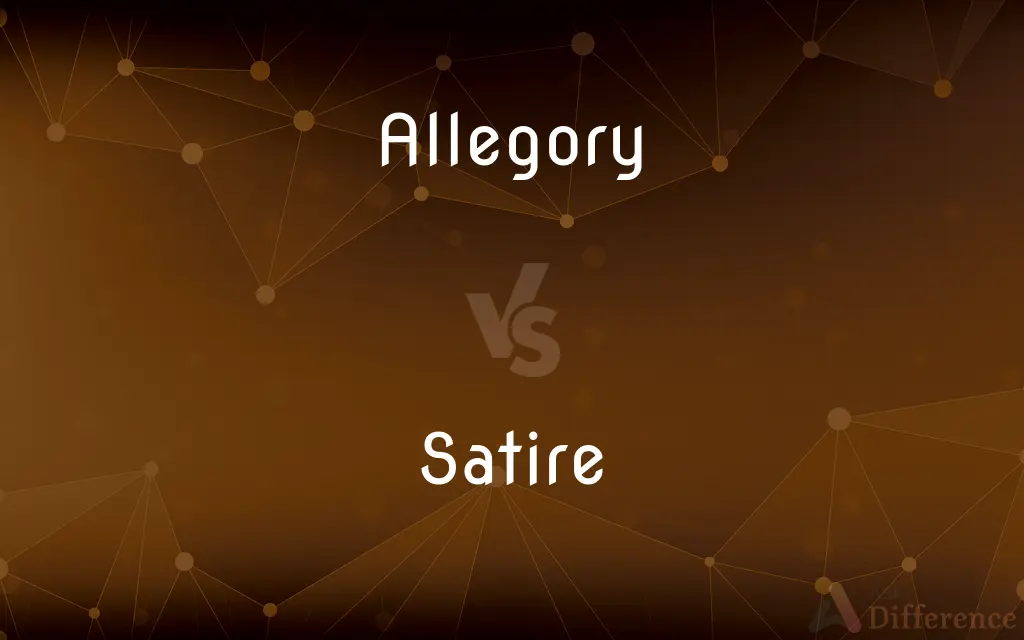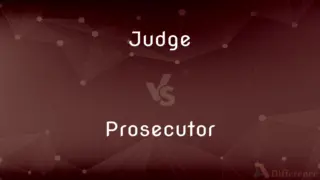Allegory vs. Satire — What's the Difference?
By Tayyaba Rehman — Updated on November 5, 2023
Allegory is a narrative with a symbolic meaning, while satire uses humor or ridicule to criticize and expose flaws.

Difference Between Allegory and Satire
Table of Contents
ADVERTISEMENT
Key Differences
Allegory and satire are literary devices used to convey messages, but they do so in distinct manners. An allegory is a complete narrative that involves characters and events symbolizing deeper truths or generalizations about human existence. It operates on a dual level of meaning - literal and symbolic. Satire, on the other hand, is a technique employed by writers to expose and criticize foolishness and corruption of an individual or society by using humor, irony, exaggeration, or ridicule.
While an allegory relies on symbolism to convey its message, often embodying moral or political meanings, satire tends to target specific events or people with its wit. Allegory aims to teach a lesson or illustrate an abstract truth. For instance, "Animal Farm" by George Orwell is an allegory for the Russian Revolution, where characters represent historical figures. In contrast, satire is less about teaching and more about exposing vices or follies. Jonathan Swift's "A Modest Proposal" is satire, using irony to comment on the conditions of the poor in Ireland.
Allegory can be timeless, offering insight into universal human experiences through veiled references. It often relies on a serious tone to unfold its layered meanings. In contrast, satire is often temporal, commenting on current events or specific issues of the time, usually with a comedic or caustic tone. Allegorical stories like "The Pilgrim’s Progress" by John Bunyan present characters and events as symbols, while satirical works like "Saturday Night Live" segments poke fun at modern events and figures.
The function of allegory can be to conceal the truth behind a veil of fiction to either protect the author from repercussions or to engage the reader to decipher the deeper meanings. Satire's function is more transparent, aiming to reveal the truth through sharp wit and often shock the audience into recognition. The characters in an allegory like "The Chronicles of Narnia" by C.S. Lewis symbolize a deeper religious and moral story, while satire, such as seen in "The Daily Show," uses sarcasm and irony to reflect on real-life politics and media.
In their intention to comment on society, politics, or human nature, both allegory and satire are similar. However, allegory invites readers into a figurative realm, with every character and event representing something else, leading to an interpretative reading experience. In contrast, satire is less about a parallel meaning and more about a direct engagement with reality, often intending to provoke change through its critique.
ADVERTISEMENT
Comparison Chart
Definition
A symbolic narrative with deeper meaning.
A genre ridiculing to expose flaws or criticize.
Purpose
To teach moral, ethical, or political lessons.
To mock, criticize, and provoke change.
Method
Symbolism and metaphor.
Humor, irony, exaggeration, ridicule.
Tone
Often serious and instructive.
Usually humorous, caustic, or scornful.
Examples
"The Pilgrim's Progress," "Animal Farm."
"A Modest Proposal," "Saturday Night Live."
Characters
Represent abstract concepts or principles.
Often exaggerated versions of real people.
Temporality
Timeless; not bound to a specific period.
Often contemporary, relating to current events.
Reader Engagement
Requires interpretation of deeper meanings.
Direct engagement through recognition of issues.
Emotional Effect
Reflection and contemplation.
Amusement, shock, or indignation.
Compare with Definitions
Allegory
A device in literature for expressing complex ideas through symbolism.
Hawthorne's The Scarlet Letter uses allegory to explore themes of sin and redemption.
Satire
A work that uses wit to criticize societal norms.
The Simpsons often uses satire to comment on family and societal dynamics.
Allegory
A story with characters and events that stand for abstract ideas or events.
The Faerie Queene is an allegory for the virtues of man.
Satire
A literary genre that uses humor to expose human folly.
The Onion is well-known for its satire on everyday news.
Allegory
Fictional writing with a moral or political message.
The Lion, the Witch and the Wardrobe is an allegory for Christian redemption.
Satire
Art or writing that ridicules vices or follies.
Gulliver’s Travels is a satire that mocks the nature of humans.
Allegory
As a literary device, an allegory is a narrative in which a character, place, or event is used to deliver a broader message about real-world issues and occurrences. Authors have used allegory throughout history in all forms of art to illustrate or convey complex ideas and concepts in ways that are comprehensible or striking to its viewers, readers, or listeners.
Satire
Employing sarcasm and irony to deride subjects.
Her satirical article made us laugh at the absurdities of office life.
Allegory
A story, poem, or picture that can be interpreted to reveal a hidden meaning, typically a moral or political one
Pilgrim's Progress is an allegory of the spiritual journey
Satire
Satire is a genre of the visual, literary, and performing arts, usually in the form of fiction and less frequently non-fiction, in which vices, follies, abuses, and shortcomings are held up to ridicule, with the intent of shaming individuals, corporations, government, or society itself into improvement. Although satire is usually meant to be humorous, its greater purpose is often constructive social criticism, using wit to draw attention to both particular and wider issues in society.
Allegory
The representation of abstract ideas or principles by characters, figures, or events in narrative, dramatic, or pictorial form.
Satire
A literary work in which human foolishness or vice is attacked through irony, derision, or wit.
Allegory
A story, picture, or play employing such representation. John Bunyan's Pilgrim's Progress and Herman Melville's Moby-Dick are allegories.
Satire
The branch of literature constituting such works.
Allegory
A symbolic representation
The blindfolded figure with scales is an allegory of justice.
Satire
Irony, sarcasm, or caustic wit used to attack or expose human foolishness or vice.
Allegory
(rhetoric) A narrative in which a character, place, or event is used to deliver a broader message about real-world issues and occurrences.
Satire
(uncountable) A literary device of writing or art which principally ridicules its subject often as an intended means of provoking or preventing change or highlighting a shortcoming in the work of another. Humor, irony, and exaggeration are often used to aid this.
Allegory
A picture, book, or other form of communication using such representation.
Satire
(countable) A satirical work.
A stinging satire of American politics.
Allegory
A symbolic representation which can be interpreted to reveal a hidden meaning, usually a moral or political one.
Satire
Severity of remark.
Allegory
A category that retains some of the structure of the category of binary relations between sets, representing a high-level generalisation of that category.
Satire
A composition, generally poetical, holding up vice or folly to reprobation; a keen or severe exposure of what in public or private morals deserves rebuke; an invective poem; as, the Satires of Juvenal.
Allegory
A figurative sentence or discourse, in which the principal subject is described by another subject resembling it in its properties and circumstances. The real subject is thus kept out of view, and we are left to collect the intentions of the writer or speaker by the resemblance of the secondary to the primary subject.
Satire
Keeness and severity of remark; caustic exposure to reprobation; trenchant wit; sarcasm.
Allegory
Anything which represents by suggestive resemblance; an emblem.
Satire
Witty language used to convey insults or scorn;
He used sarcasm to upset his opponent
Irony is wasted on the stupid
Satire is a sort of glass, wherein beholders do generally discover everybody's face but their own
Allegory
A figure representation which has a meaning beyond notion directly conveyed by the object painted or sculptured.
Satire
A comedic approach to bringing about awareness and change.
The satirical play left the audience reflecting on political corruption.
Allegory
A short moral story (often with animal characters)
Allegory
A visible symbol representing an abstract idea
Allegory
An expressive style that uses fictional characters and events to describe some subject by suggestive resemblances; an extended metaphor
Allegory
A narrative that serves as an extended metaphor.
Plato's Allegory of the Cave illustrates the effects of education on human nature.
Allegory
An artistic representation conveying a deeper, often spiritual, meaning.
In the allegory of Moby Dick, the whale represents the unknowable.
Common Curiosities
What is an allegory in literature?
An allegory is a narrative with symbols representing broader themes or ideas, often moral or political.
Are allegories always fictional?
Yes, allegories are fictional narratives with symbolic meanings beyond the literal plot.
What is the main purpose of allegory?
The main purpose of allegory is to illustrate abstract principles or truths through symbolic storytelling.
Can satire be found in forms other than writing?
Yes, satire can be found in various forms, including visual art, film, and performance.
Is satire always negative?
Satire is critical by nature, but it can also be affectionate and highlight positive aspects as a contrast.
Can children’s stories be allegorical?
Yes, many children's stories have allegorical elements teaching lessons about life.
How does satire aim to affect the audience?
Satire aims to provoke thought, amusement, or change by criticizing or mocking its subject.
Are parodies and satire the same?
No, parodies mimic for comic effect, while satire uses humor for criticism.
What makes a story an allegory?
A story is an allegory when its characters and events metaphorically represent real-life issues or moral concepts.
Does satire have to be funny?
Satire often uses humor, but its primary goal is critique, not necessarily to evoke laughter.
How do readers interpret allegories?
Readers interpret allegories by analyzing the symbolic meaning of the characters and events.
Do satirical works target specific individuals?
Satire can target specific individuals, behaviors, or wider societal norms.
How is allegory different from symbolism?
Allegory is an extended form of symbolism where the entire narrative is symbolic.
Is it possible for a work to be both allegorical and satirical?
Yes, some works can employ both allegory and satire to deliver complex critiques.
Why is satire important in society?
Satire is important as it challenges norms, encourages critical thinking, and can inspire societal change.
Share Your Discovery

Previous Comparison
Judge vs. Prosecutor
Next Comparison
Enough vs. AmpleAuthor Spotlight
Written by
Tayyaba RehmanTayyaba Rehman is a distinguished writer, currently serving as a primary contributor to askdifference.com. As a researcher in semantics and etymology, Tayyaba's passion for the complexity of languages and their distinctions has found a perfect home on the platform. Tayyaba delves into the intricacies of language, distinguishing between commonly confused words and phrases, thereby providing clarity for readers worldwide.














































